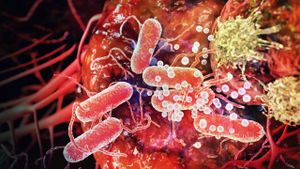New Delhi is once again grappling with its year-round battle against severe air pollution, particularly alarming as the air quality index (AQI) soared to as high as 494 this week. This figure categorizes the air quality as ‘severe plus’, posing serious health risks to residents across the capital.
On Tuesday, the air quality measured significantly above even hazardous levels, with monitoring stations reporting AQI values nudging the upper limit of 500. Such conditions have prompted immediate and drastic emergency measures from the government aimed at mitigating the health impacts and distressing visibility challenges across the region.
Authorities swiftly activated Stage IV of the Graded Response Action Plan (GRAP), which includes stringent restrictions like banning trucks except those carrying essentials and suspending all construction activities. These measures are not just precautionary; they become urgent when the daily AQI levels touch figures over 300, as highlighted by the Supreme Court’s intervention, demanding the government act sooner to safeguard citizen health.
Residents woke up to thick clouds of smog enveloping the city, blurring outlines of typical landmarks and limiting visibility. The capital's situation worsened to the point where schools have made the transition to online classes, impacting students' routines. Delhi University, along with other educational institutions, has directed students to stay home for remote lessons until conditions improve. The Supreme Court also acknowledged the plight of students by ordering online classes to shield them from the toxic air.
Train and flight operations faced significant disruptions, with over 180 flights delayed as visibility at the Indira Gandhi International Airport worsened. The rail network reported delays for at least 22 trains, with passengers forced to adjust their travel plans under these trying conditions. Public transportation, including buses, has also seen delays as residents navigate their day through the heavy haze.
This year’s pollution crisis has alarming similarities to previous winters, primarily driven by recurring practices such as crop residue burning, which is prevalent among farmers in neighboring states like Punjab and Haryana. Farmers commonly set fire to straw after harvesting, contributing massively to the smog settling over the capital. Despite efforts by local authorities to curtail stubble burning, incidents still resulted in significant spikes of particulate matter detected over the region.
Health experts have not shied away from calling the deteriorated air quality levels a public health emergency. They warn of the serious risks posed by prolonged exposure to airborne toxins. PM2.5 levels, the main pollutants of concern, can penetrate deep within the lungs and even enter the bloodstream, causing heart complications and respiratory diseases. Reports indicate particulate levels up to 60 times greater than recommended by the World Health Organization (WHO), raising alarms about long-term effects on public health.
Given the challenging air quality, calls have intensified for clearer and swifter action by officials. Delhi Environment Minister Gopal Rai has made suggestions for urgent interventions, including the possibility of artificial rain to clear the smog temporarily. He reached out to the Prime Minister, emphasizing the urgency of the situation and the need for impactful and immediate actions.
Compounding the woes of residents is the drop in temperature characteristic of the winter months. Cooler air is denser, trapping pollutants close to the ground and creating the perfect storm for worsening air quality, especially as lower wind speeds prevent dispersal.
The broader health impacts of air pollution have been underscored by multiple studies, reinforcing the need for comprehensive interventions. Lack of substantial government measures has raised concerns among environmentalists and public health advocates alike. They call for nurturing cleaner energy sources, reducing reliance on fossil fuels, and implementing sustainable urban planning to mitigate recurrent pollution crises.
Meanwhile, the capital's residents remain painfully aware of their daily realities as the smog continues to cloud their lives. Citizens have been reported wearing masks, avoiding outdoor activities, and keeping indoor air purifiers running to shield themselves from the pervasive effects of pollution.
Even as authorities enforce immediate measures, experts argue for long-term strategies to address the root causes of pollution. While seasonal influences make such spikes predictable, systemic change is needed to tackle the chronic nature of Delhi's air quality issues. The government has been urged to engage more thoroughly with neighboring states to effectively coordinate efforts against practices contributing to seasonal pollution.
Health organizations and government officials continue to work collaboratively to devise effective strategies to cope with this annual crisis. But for now, the residents of New Delhi remain vigilant, hoping for relief from the choking smog as they navigate the uncertain months of winter, filled with anxiety about the air they breathe.
The latest air quality reports, though disheartening, serve as reminders of the multifaceted challenges posed by urbanization and seasonal agricultural practices. Unless decisive action is taken, the residents of New Delhi will remain at the foothills of government policies, hoping for fresh air as winter approaches.



